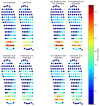A Portable Insole System for Actively Controlled Offloading of Plantar Pressure for Diabetic Foot Care
- PMID: 40573707
- PMCID: PMC12196993
- DOI: 10.3390/s25123820
A Portable Insole System for Actively Controlled Offloading of Plantar Pressure for Diabetic Foot Care
Abstract
Plantar pressure monitoring is decisive in injury prevention, especially in at-risk populations such as people with diabetic foot. In this context, innovative solutions such as pneumatic insoles can be essential in plantar pressure management. This study describes the development of a variable pressure system that promotes the monitoring, stabilization, and offloading of plantar pressure through a pneumatic insole. This research was also intended to evaluate its ability to redistribute plantar pressure, reduce peak pressure in both static and dynamic conditions, and validate its pressure measurements by comparing the results with those obtained from a pedar® insole. Tests were carried out under both static and dynamic conditions, before and after the pressure stabilization process by air cells and the subsequent pressure offloading. During the validation process, methods were used to evaluate the agreement between measurements obtained by the two systems. The results of the static test showed that pressure stabilization reduced pressure on the heel by 32.43%, distributing it to the metatarsals and toes. After heel pressure offloading, the reduction reached 42.72%. In the dynamic test, despite natural dispersion of the measurements, a trend to reduce the peak pressure in the heel, metatarsals, and toes was observed. Agreement analysis recorded 96.32% in the static test and 94.02% in the dynamic test. The pneumatic insole proved effective in redistributing and reducing plantar pressure, with more evident effects in the static test. Its agreement with the pedar® system reinforces its reliability as a tool for measuring and managing plantar pressure, representing a promising solution for preventing plantar lesions.
Keywords: diabetic foot; health and safety; offloading; plantar pressure; pneumatic insole; ulcers; wearable sensors.
Conflict of interest statement
The authors declare no conflicts of interest. The funders had no role in the design of the study; in the collection, analyses, or interpretation of data; in the writing of the manuscript; or in the decision to publish the results.
Figures













References
-
- International Diabetes Federation . IDF Diabetes Atlas. 10th ed. International Diabetes Federation; Brussels, Belgium: 2021.
-
- Schaper N.C., van Netten J.J., Apelqvist J., Bus S.A., Fitridge R., Game F., Monteiro-Soares M., Senneville E., on behalf of the IWGDF Editorial Board Practical guidelines on the prevention and management of diabetes-related foot disease (IWGDF 2023 update) Diabetes Metab. Res. Rev. 2024;40:e3657. doi: 10.1002/dmrr.3657. - DOI - PubMed
MeSH terms
Grants and funding
LinkOut - more resources
Full Text Sources
Medical

